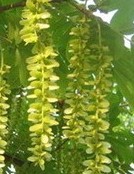 Chinese wingnut is a deciduous tree native to Southeast China where it grows in forests on mountain slopes or riverbanks. It is in the walnut family, Juglandaceae, that also includes pecan and hickory. The trees are usually multiple-trunked with branches low to the ground, a spreading habit, and dense rounded canopy. The leaves are pinnately compound, six to fifteen inches long, and composed of eleven to twenty-three lanceolate leaflets two to four inches long, shiny dark green, and with serrated margins. In late spring non-showy light green male and female flowers appear on the same tree in catkins seven inches and twenty inches long respectively. In early summer the female catkins produce two-winged fruits that are ornamentally attractive, mature to brown, and may remain on the tree until winter. Chinese walnut is very fast growing, has a suckering habit and shallow aggressive roots that make the tree unsuitable for lawns or sites near patios, sidewalks, or driveways. Although a good shade tree, it is more suited to large planting than a home garden. The genus name, Pterocarya, comes from the Greek words, pteron, meaning winged, and karyon, meaning nut. The specific epithet comes from the Greed words stenos meaning narrow, and ptero meaning winged.
Chinese wingnut is a deciduous tree native to Southeast China where it grows in forests on mountain slopes or riverbanks. It is in the walnut family, Juglandaceae, that also includes pecan and hickory. The trees are usually multiple-trunked with branches low to the ground, a spreading habit, and dense rounded canopy. The leaves are pinnately compound, six to fifteen inches long, and composed of eleven to twenty-three lanceolate leaflets two to four inches long, shiny dark green, and with serrated margins. In late spring non-showy light green male and female flowers appear on the same tree in catkins seven inches and twenty inches long respectively. In early summer the female catkins produce two-winged fruits that are ornamentally attractive, mature to brown, and may remain on the tree until winter. Chinese walnut is very fast growing, has a suckering habit and shallow aggressive roots that make the tree unsuitable for lawns or sites near patios, sidewalks, or driveways. Although a good shade tree, it is more suited to large planting than a home garden. The genus name, Pterocarya, comes from the Greek words, pteron, meaning winged, and karyon, meaning nut. The specific epithet comes from the Greed words stenos meaning narrow, and ptero meaning winged.
Type: Deciduous tree
Outstanding Feature: Fruit
Form: Vase shaped with rounded crown
Growth Rate: Rapid
Bloom: Non-showy light green male and female flowers appear on the same tree in catkins seven inches and twenty inches long respectively, in late spring
Size: 30-70’ H x 30-70’ W
Light: Full sun
Soil: Average, medium moist, well-drained
Hardiness: Zones 6-8
Care: Prune in fall to train and shape.
Pests and Diseases: None of significance
Propagation: Seed, cuttings, division of suckers